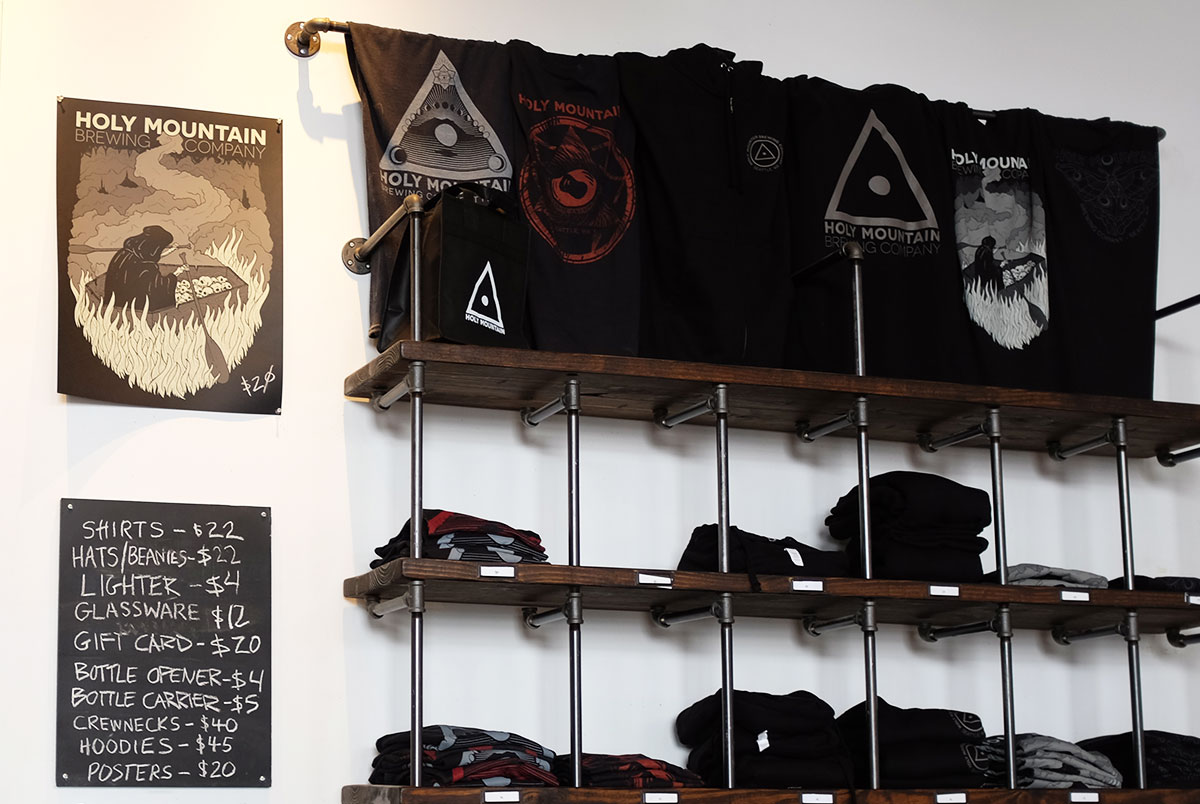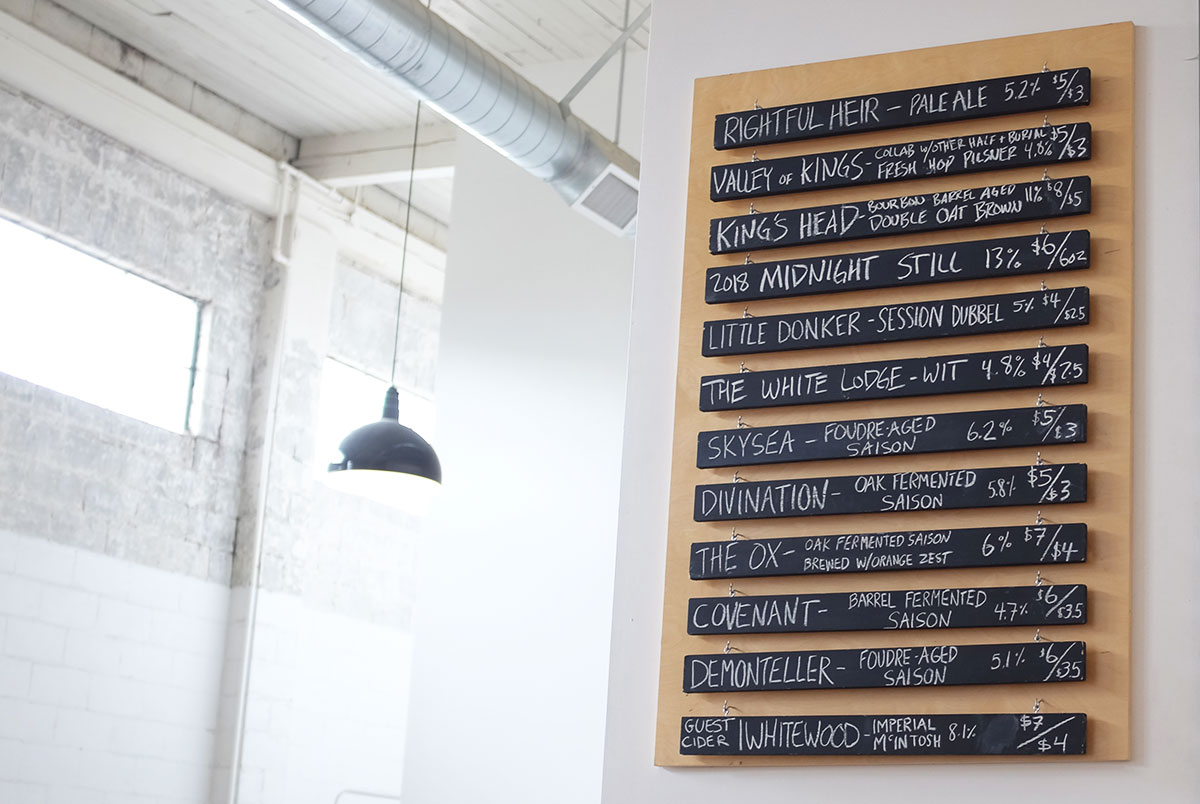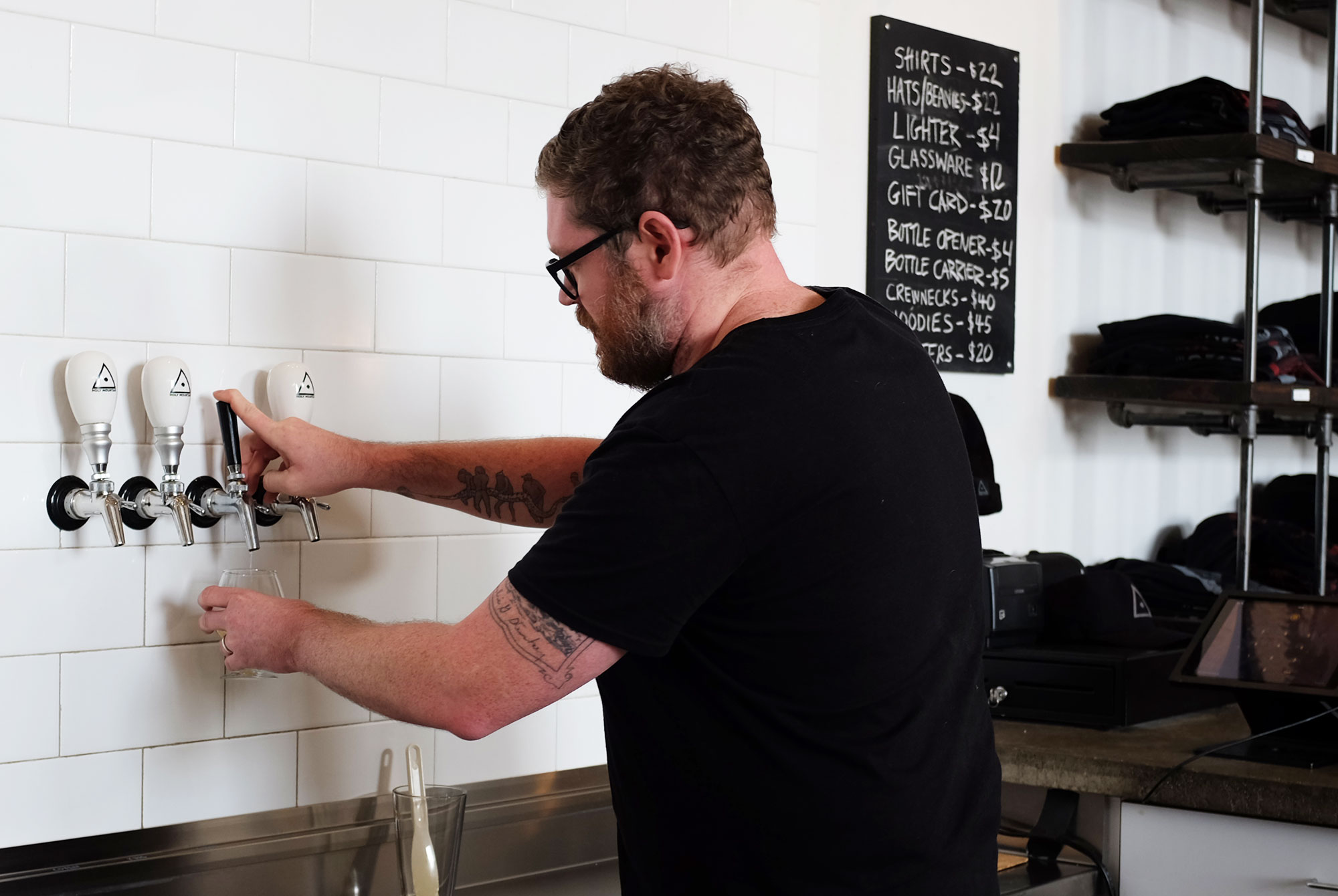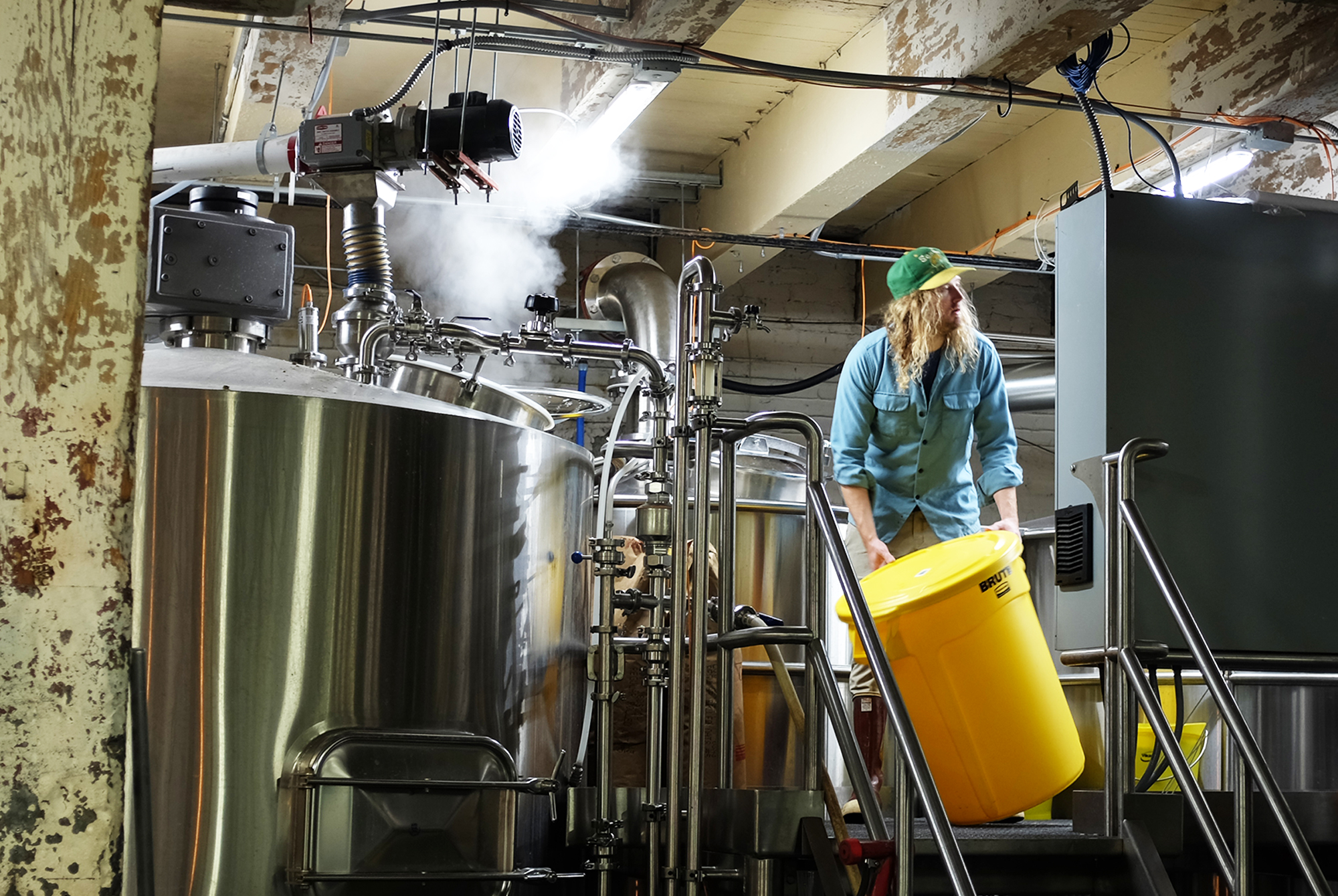Shop
Crush Some Metal As We Interview Holy Mountain
Finding metal at the intersection of rustic and modern.
Earlier in the year, Hop Culture Managing Editor John Paradiso and I went to Other Half Brewing’s Green City Festival in Brooklyn. We tried a lot of breweries we really liked (shoutout to J. Wakefield and Northern Monk), but the only brewery that made us come back for seconds, thirds, and maybe even fourths was Holy Mountain Brewing… and with a pilsner, no less. Not only that, but the brewers manning the booth were friendly, approachable, and knowledgeable. I knew I had to visit.
Flash forward several months, and I found myself outside the garage door of Holy Mountain’s taproom in Seattle. In the last several years, it seems like brewers have followed one of two paths to success — The Alchemist Model, in which they produce and can hazy IPAs, or the Hill Farmstead Model, in which they produce and bottle Old World styles. I’d place Holy Mountain into the latter category. Although the brewery always tries to have a hoppy beer on tap, they’re probably best known for their mixed-culture program, and they use oak almost as much as they use stainless steel. The result is a fascinating blend of rustic and modern, with a little bit of metal thrown in for good measure.
While at the taproom, I sat down with Mike Murphy, co-founder of Holy Mountain, to talk about his influences, and how he and Colin Lenfesty built one of the Pacific Northwest’s most iconic beer brands.
Kenny Gould: So how did you and Colin meet?
Mike Murphy: We actually worked together at a brewery in South Seattle called Schooner Exact. I was there close to five years running the sales program. About a year and a half after I started, he was hired on and quickly moved up to a brewing position. We just hit it off. Early on, we talked about doing something like this, and it was a good three-year process from the time we signed a business plan to the time we signed a lease. That actually helped — we got to know the local industry and the market really well. We were able to come out of the gate swinging, and people were excited about what we were doing.
KG: And what year was this?
MM: We signed our lease at the beginning of 2014. We started brewing in September 2014 and opened in January 2015.
KG: The art seems like a big piece of the brand.
MM: That was always something really important to us. We’d all grown up involved — in one way or another — in music. We took the approach a lot of bands take with rotating merchandise. So we do shorter, like 150 or 200 run prints. So we don’t have the same things that often. And as far as beers go, we don’t have anything we brew year round, so we knew that those labels were going to change as well. We’ve ended up with really cool sidebrands, more or less. All our larger run saisons have those white labels with the animal heads. Brian Steely is an artist out of Atlanta, he did those designs. Everything else is done in-house by Ryan Williams, who’s our artist here.

KG: So you looked to music as inspiration for the art, but also for the business?
MM: More or less for the merch. When we opened, the older school brewpub model was what you saw. People making six year-round beers and maybe one seasonal. That was the kind of brewery we worked for initially, but we really wanted to not have to stick to that schedule. We wanted smaller batch, more specialized beers. We wanted to brew what we wanted. That was the idea behind it — not being beholden to distributors or accounts needing X beer. Especially the mixed culture stuff, that wasn’t being brewed that much in Seattle, and that’s what we really loved to do. At first, we were nervous, not knowing if people would take to it, but they definitely did.
KG: It’s so wild that was just a few years ago.
MM: A lot of great spots have opened in the past few years. The Seattle scene, in general, has grown and transformed.
KG: Do you make merch independent of the beer?
MM: We make tons of shirts that have no association with the beer. A good chunk of them actually. Those last two over there are associated with beers, but very loosely. They don’t even have the beer name on them. If we do beer specific shirts, we usually roll them out on a release day, and they go pretty quickly.
KG: Do you do glass as well?
MM: Some.
KG: But mostly shirts?
MM: Yeah shirts. A lot of shirts, hoodies, and hats. We do glassware once in a while, but there’s a weird culture with glassware. People are so intense about it, so we try and minimize that weirdness. Everyone wears t-shirts, but the glassware… it’s crazy how into glassware people can be. We’ve done a few different glasses that reference Twin Peaks. Our last glass was the carpet from The Shining.
KG: Does the merch sell well online?
MM: I think with the online store, if you don’t promote it in any way or show that you’re rotating something new… the promotion directly correlates with how many sales you get. People aren’t just going online shopping at brewery stores every day, but if they see a post about something, we see a huge spike. It’s the same here. If we have a new shirt and put it into the world, people come.
KG: Do people ever come in just for clothes?
MM: Sometimes. Most of the time, people at least have a beer. Though one time, we did have a guy come in and say he was buying his fifty-second Holy Mountain shirt.
KG: Who in the industry do you admire?
MM: Locally, you know the Cloudburst guys. Steve’s been a good friend for a long time, long before either of us did our own breweries. His sales guy Noah worked with me and Colin at Schooner Exact. People like the guys at Cloudburst and Stoup… as far as local beer goes, they’re top notch people doing really amazing stuff. We’re all on a smaller scale, but we bounce ideas off each other all the time. We do events together and make beer together. It’s good to have contacts like that locally.
Across the country, seeing the kind of shit that Oxbow is cranking out is really inspiring. We’ve become good friends with the Other Half guys, the Monkish guys, and we like seeing the way those two brands have transformed. We’re not super involved in the can game ourselves, but just watching how those brands have changed the landscape has been cool.
We’ve really come to the realization that the beer community is exactly that — a community. One that shares knowledge and experience and practices very openly, so anytime we travel and do a collaboration or visit another brewery, or spend time with fellow brewers and brewery owners, we definitely come home inspired to try new things and improve our existing practices. That might sound like a more generalized answer, but I think it’s the truth that our best inspiration comes from spending time with fellow brewers around the country and seeing what a tight-knit, accepting, and boundary-pushing community we’re involved in.
KG: If you could describe the Holy Mountain ethos, what would it be?
MM: We use a lot of older brewing practices. We do a lot of primary fermentation in oak. It’s a bit of a blend from the old world to the modern. The aesthetic is clean and occult-y and metal inspired, but the beers themselves are produced in a pretty rustic way. Oak fermentation is a huge part of the business. We use oak almost as much as we use stainless. Over the summer, we use more stainless because we’re cranking beers out, but we do a lot of primary in oak and that’s a pretty old-school way to go about it. In that way, bringing the rustic into this new, modern, darker cultish vibe.

KG: What about the taproom aesthetic? Where does that come from?
MM: Early on, we knew heavy music was going to inspire sides of the brand no matter what. Naming ourselves after a Sleep album, it’s going to creep in. When we decided on the vibe of the taproom, we thought, Well, we can’t just make it all black. Why not make it all white? That’s a little more metal. It’s a little more sterile and institutional and creepier than an all-black taproom.
KG: I talk to a lot of brewers who are really into metal. Why do you think that is?
MM: I think there’s a kind of counter-culture aspect to beer. With any kind of underground music scene, there’s this vibe that there’s corporate music, and then it’s like, we’re going to do our own thing and go our own route. I think beer is very much like that. There are big guys, big players, but the people involved in a smaller way are going to band together. Fuck the big guys. We’re going to do our own thing and make our own way in an industry that’s existed for a long time. I think they play really well. It has been funny how many people in the industry are way like-minded, and that’s pretty cool to see. That’s my guess why people get into both.
KG: So with that counter-culture element, you’re probably not thinking, this is hot right now, let’s make this?
MM: We always have some kind of hoppy beer on tap. We still wanted to make hoppy beers, and we do some clean Northwest styles and some hazy. But we wanted to showcase those in-house because those beers can be fragile and change the further out they’re sent. Making hoppy beers has always been important to us, but we want to showcase them locally. The mixed culture stuff, that side was always what we wanted to do and we wanted to do that in bottles with natural conditioning.
KG: Was there anyone else doing that in Seattle? Or did it really start at Holy Mountain?
MM: It was very heavy in the market. A lot of mixed culture beers were being distributed here. But no one was really focusing on it. That was a big part of why we chose that style. People were drinking it in Seattle, but no one locally was really focused on their barrel program. That was a big part of why we wanted to push that, and we’re really happy that it’s taken off. We want those beers to be really drinkable too, so they’re not over the top sour, over the top in one direction or another. We want drinkable and approachable but still complex. A lot of times, people go for heavier flavors, but they’ve really taken to our beer. We usually have four or five saisons on at a time so people can try a whole range of mixed culture stuff.
KG: Do you have any songs for a brewer’s playlist?
MM: Most of our bottle releases, we play Sleep’s Dopesmoker. So anything off of that.
Liked this article? Sign up for our newsletter to get the best craft beer writing on the web delivered straight to your inbox.




